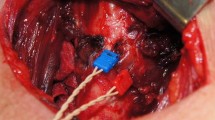Abstract
Background
Injury to the external branch of the superior laryngeal nerve (EBSLN) can occur during superior pole dissection in thyroid surgery; the EBSLN injury rate is reported as high as 28 % (Cernea et al., Head Neck 14:380–383, 1992). Injury to the EBSLN leads to variable symptoms that may be overlooked, but that can be significant, especially to professional speakers and singers. Intraoperative nerve monitoring (IONM) is employed widely to aid in nerve identification. We report on normative electroneuromyography (EMG) data on EBSLN-IONM and cricothyroid muscle (CTM) twitch response during stimulation as an aid to EBSLN identification.
Methods
A prospective study of the SLN and the recurrent laryngeal nerve (RLN) IONM data in 72 consecutive thyroid surgeries was carried out. All patients underwent preoperative and postoperative laryngeal exams, and patients with abnormal preoperative laryngeal function were excluded. Normative EMG data and CTM twitch response during EBSLN stimulation were recorded and analyzed.
Results
Stimulation of the EBSLN resulted in a positive CTM twitch response in 100 %, whereas EMG response was recordable in 80 %. Electromyographic amplitude was ~1/3 of ipsilateral RLN amplitude and did not change through the case with multiple stimulations. Stimulation of the EBSLN was similar for men and women and at 1 and 2 mA stimulation levels.
Conclusions
Intraoperative nerve monitoring of the EBSLN aids in EBSLN identification and provides electroneuromyographic information in 80 % of cases. The laryngeal head of the sternothyroid muscle is a useful landmark to locate EBSLN.



Similar content being viewed by others
References
Cernea CR, Ferraz AR, Nishio S et al (1992) Surgical anatomy of the external branch of the superior laryngeal nerve. Head Neck 14:380–383
Randolph GW, Dralle H, Abdullah H et al (2011) Electrophysiologic recurrent laryngeal nerve monitoring during thyroid and parathyroid surgery: international standards guideline statement. Laryngoscope 121(Suppl 1):S1–S16
Cernea CR, Ferraz AR, Furlani J et al (1992) Identification of the external branch of the superior laryngeal nerve during thyroidectomy. Am J Surg 164:634–639
Jonas J, Bahr R (2000) Neuromonitoring of the external branch of the superior laryngeal nerve during thyroid surgery. Am J Surg 179:234–236
Friedman M, LoSavio P, Ibrahim H (2002) Superior laryngeal nerve identification and preservation in thyroidectomy. Arch Otolaryngol Head Neck Surg 128:296–303
Selvan B, Babu S, Paul MJ et al (2009) Mapping the compound muscle action potentials of cricothyroid muscle using electromyography in thyroid operations: a novel method to clinically type the external branch of the superior laryngeal nerve. Ann Surg 250:293–300
Lifante JC, McGill J, Murry T et al (2009) A prospective, randomized trial of nerve monitoring of the external branch of the superior laryngeal nerve during thyroidectomy under local/regional anesthesia and IV sedation. Surgery 146:1167–1173
Dionigi G, Boni L, Rovera F et al (2009) Neuromonitoring and video-assisted thyroidectomy: a prospective, randomized case–control evaluation. Surg Endosc 23:996–1003
Meyer T, Hamelmann W, Timmermann W et al (2006) The advantages and disadvantages of nerve monitoring during thyroid surgery in childhood. Eur J Pediatr Surg 16:392–395
Sanudo JR, Maranillo E, Leon X et al (1999) An anatomical study of anastomoses between the laryngeal nerves. Laryngoscope 109:983–987
Nasri S, Beizai P, Ye M et al (1997) Cross-innervation of the thyroarytenoid muscle by a branch from the external division of the superior laryngeal nerve. Ann Otol Rhinol Laryngol 106:594–598
Lorenz K, Sekulla C, Schelle J et al (2010) What are normal quantitative parameters of intraoperative neuromonitoring (IONM) in thyroid surgery? Langenbeck’s Arch Surg 395:901–909
Randolph GW (2002) Surgical anatomy of the recurrent laryngeal nerve. In: Randolph GW (ed) Surgery of the thyroid and parathyroid glands. Saunders, Philadelphia, pp 300–341
Bevan K, Griffiths MV, Morgan MH (1989) Cricothyroid muscle paralysis: its recognition and diagnosis. J Laryngol Otol 103:191–195
Roy N, Barton ME, Smith ME et al (2009) An in vivo model of external superior laryngeal nerve paralysis: laryngoscopic findings. Laryngoscope 119:1017–1032
Teitelbaum BJ, Wenig BL (1995) Superior laryngeal nerve injury from thyroid surgery. Head Neck 17:36–40
Adour KK, Schneider GD, Hilsinger RL Jr (1980) Acute superior laryngeal nerve palsy: analysis of 78 cases. Otolaryngol Head Neck Surg 88:418–424
Tsai V, Celmer A, Berke GS et al (2007) Videostroboscopic findings in unilateral superior laryngeal nerve paralysis and paresis. Otolaryngol Head Neck Surg 136:660–662
Lemere F (1932) Innervation of the larynx. I. Innervation of laryngeal muscles. Am J Anat 51:417–437
Sanders I, Wu BL, Mu L et al (1993) The innervation of the human larynx. Arch Otolaryngol Head Neck Surg 119:934–939
Wu BL, Sanders I, Mu L et al (1994) The human communicating nerve. An extension of the external superior laryngeal nerve that innervates the vocal cord. Arch Otolaryngol Head Neck Surg 120:1321–1328
Maranillo E, Leon X, Quer M et al (2003) Is the external laryngeal nerve an exclusively motor nerve? The cricothyroid connection branch. Laryngoscope 113:525–529
Mermelstein M, Nonweiler R, Rubinstein EH (1996) Intraoperative identification of laryngeal nerves with laryngeal electromyography. Laryngoscope 106:752–756
Barczynski M, Konturek A, Stopa M et al (2012) Randomized controlled trial of visualization versus neuromonitoring of the external branch of the superior laryngeal nerve during thyroidectomy. World J Surg 36:1340–1347. doi:10.1007/s00268-012-1547-7
Germain MA, Trotoux J, Bruneau X (1986) Laryngeal nerves. A histomorphometric and cartographic study. Ann Otolaryngol Chir Cervicofac 103:379–388
Author information
Authors and Affiliations
Corresponding author
Rights and permissions
About this article
Cite this article
Potenza, A.S., Phelan, E.A., Cernea, C.R. et al. Normative Intra-operative Electrophysiologic Waveform Analysis of Superior Laryngeal Nerve External Branch and Recurrent Laryngeal Nerve in Patients Undergoing Thyroid Surgery. World J Surg 37, 2336–2342 (2013). https://doi.org/10.1007/s00268-013-2148-9
Published:
Issue Date:
DOI: https://doi.org/10.1007/s00268-013-2148-9




